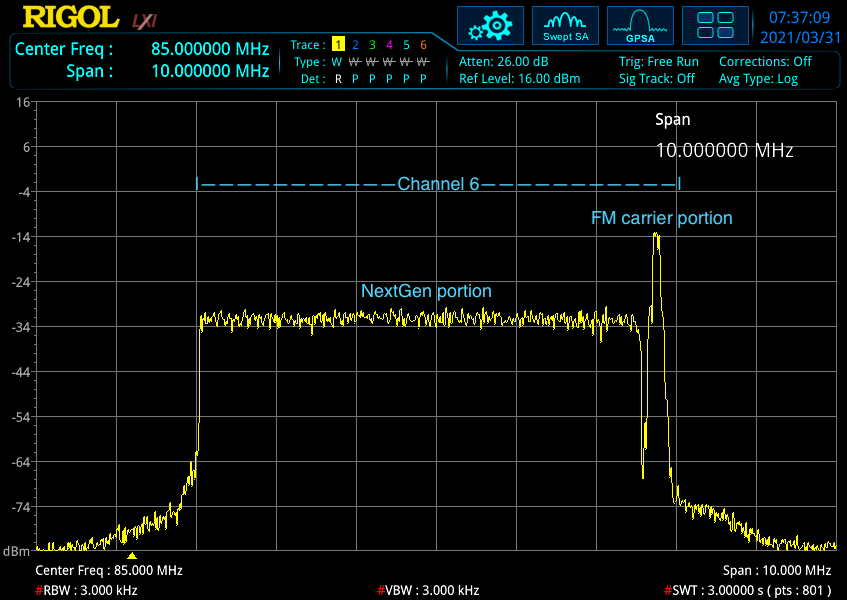KRPE-LD San Diego, low power TV channel 6, atop Mt. San Miguel, is the first local station to broadcast ATSC 3.0, marketed as “NextGen”. The FCC granted a Special Temporary Authorization (STA) for a signal that includes an innovative analog FM carrier at 87.75 MHz. According to Director of Engineering Daniel Bissett, licensee Venture Technologies Group, LLC completed construction of the new signal on October 7, 2021.

Photo by Daniel Bissett of Venture Technologies.
Analog broadcaster KRPE-LP and channel 6 low power TV stations nationwide had for years been marketing to audiences as an FM station, broadcasting aural subcarriers with high injection levels and 75 kHz FM modulation in order to attract listeners using conventional FM tuners. Many industry engineers had derisively called these “Franken FM” signals on 87.75, the traditional channel 6 visual carrier frequency. For their accompanying analog TV visual signals, they carried a static graphic, slide show, or limited video.
Bissett says Venture is broadcasting a signal at each of its channel 6 stations fully compliant with the ATSC 3.0 standard, ingenious with its flexibility. He says the scheme should be adopted by the FCC without having to ask for temporary authority. And he adds that tests have shown the signal to be compatible both with current NextGen demodulation devices and analog FM tuners.
Venture filed an application with the FCC on October 25 to license KRPE-LD as a NextGen station, confidently citing FCC rules regarding the adoption of NextGen without explaining the two-part signal. Bissett said, “This is done because the License to Cover must be granted before the STA for the FM carrier can be requested.”
Venture first implemented NextGen at its station in San Jose, KBKF-LD. Bissett says that the station first tried to use 87.70 as its FM frequency for compatibility with synthesized FM tuners but found many car tuners output unacceptable levels of distortion in their demodulated audio. When they moved to 87.75, the distortion cleared, so they adopted the old frequency in their FCC filings for their channel 6 properties: KBKF-LD San Jose, KEFM-LD Sacramento, WRME-LD Chicago, KZNO-LD Big Bear Lake (Los Angeles), and KRPE-LD San Diego. Bissett says the cause of this distortion so far remains a mystery unsolved by tuning their output filters. (On the other hand, my disciplined Sony XDR-F1HD tuner cannot demodulate an 87.75 MHz FM signal without this same distortion. )
They are using transmitters assembled by Italian manufacturer Syes and by American Amplifier Technologies of Sacramento. Com-tech of Italy makes their output filters, and Bissett says the ATSC mask filters use eight cavities.
It hasn’t been lost on Bissett that there is great potential in multicasting digital audio signals on channel 6 ATSC. Ignoring for a moment the enormous political hurdles to doing this, he says mobile reception tests of NextGen on channel 6 have been disappointing. You can see on the spectrum diagram that the average visual signal is at least 18 dB below the level of the FM carrier, so the signal tends to drop out behind terrain. He doesn’t see much future in mobile broadcasting with the present broadcast model of few, prominent transmitters. However, Qualcomm’s implementation of Forward-Link-Only TV (“FLO TV”) digital broadcasting in the late 2000s took this into account with its synchronized, multiple-transmission-point system for each of its metro markets.
For now, Venture provides only a direct response shopping channel on their visual NextGen TV signals. They are looking for revenue opportunities.
